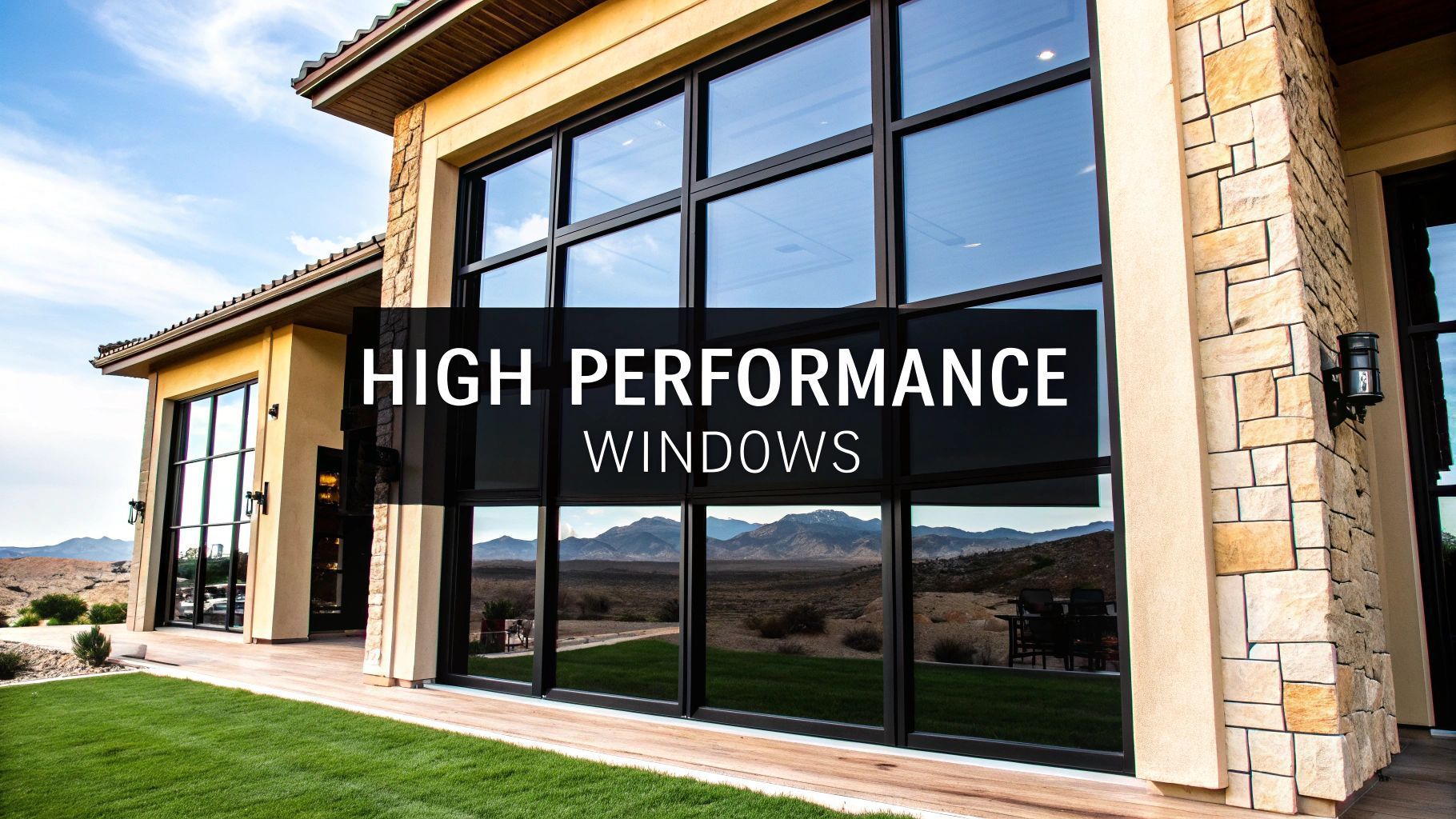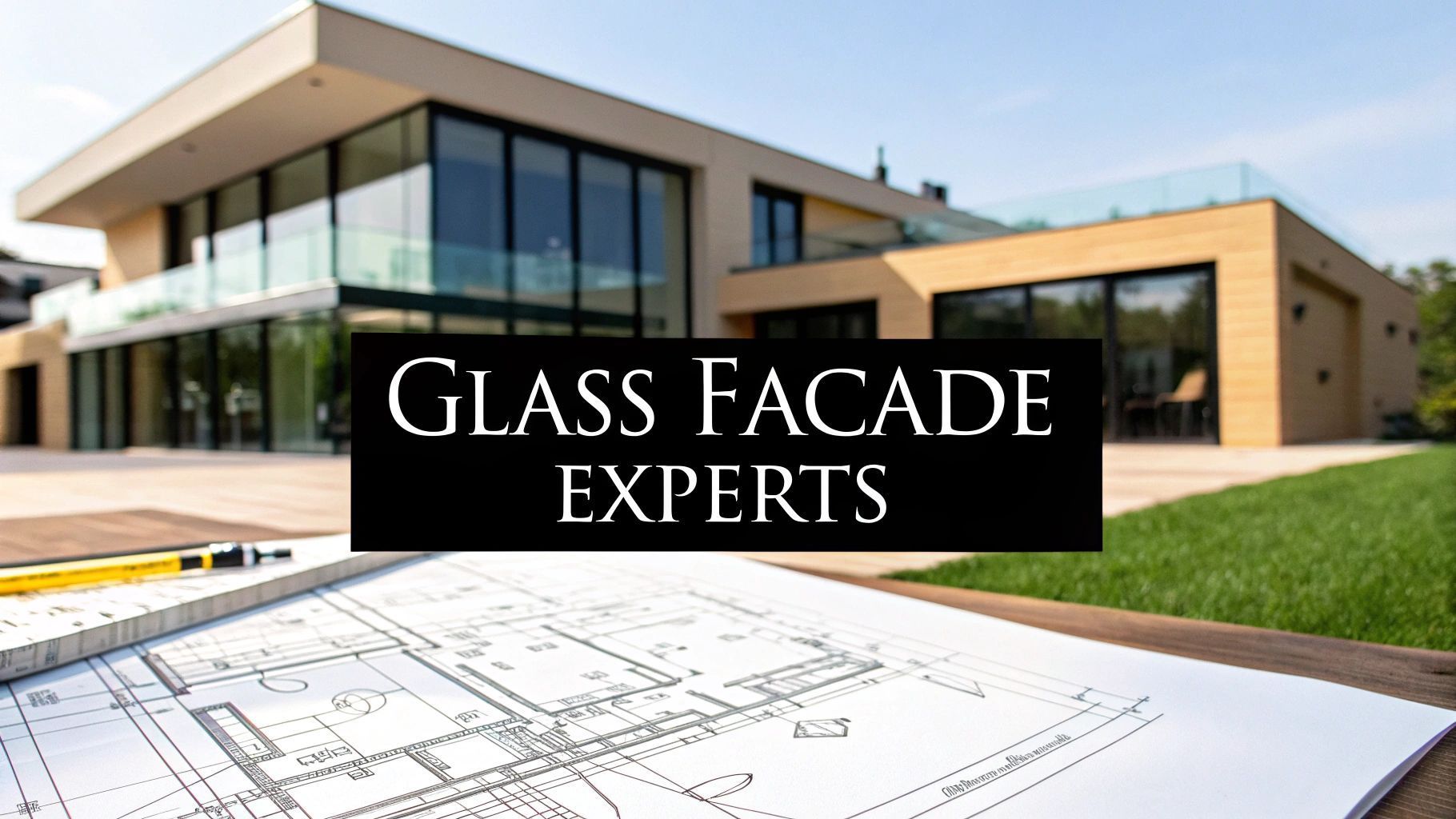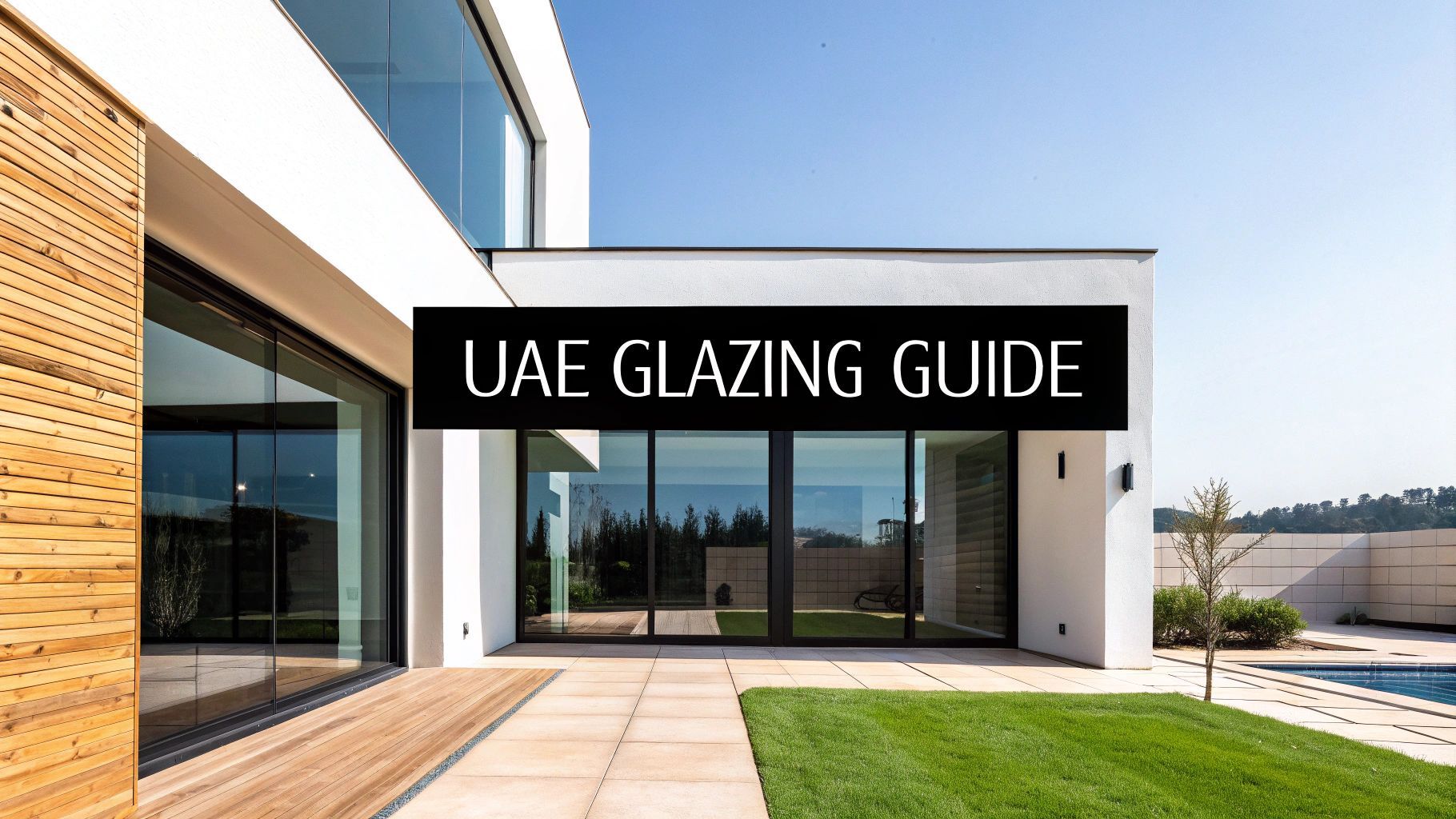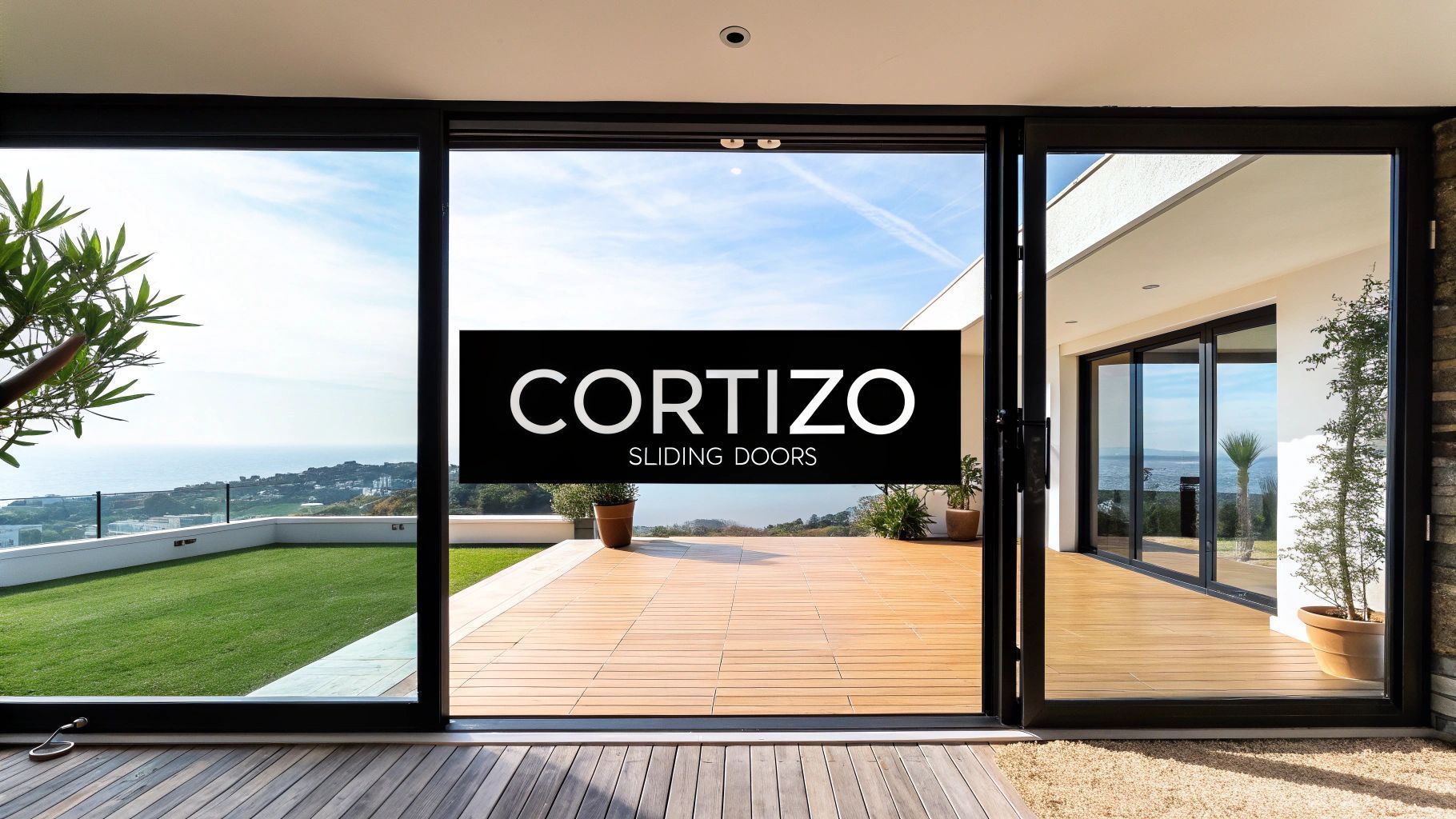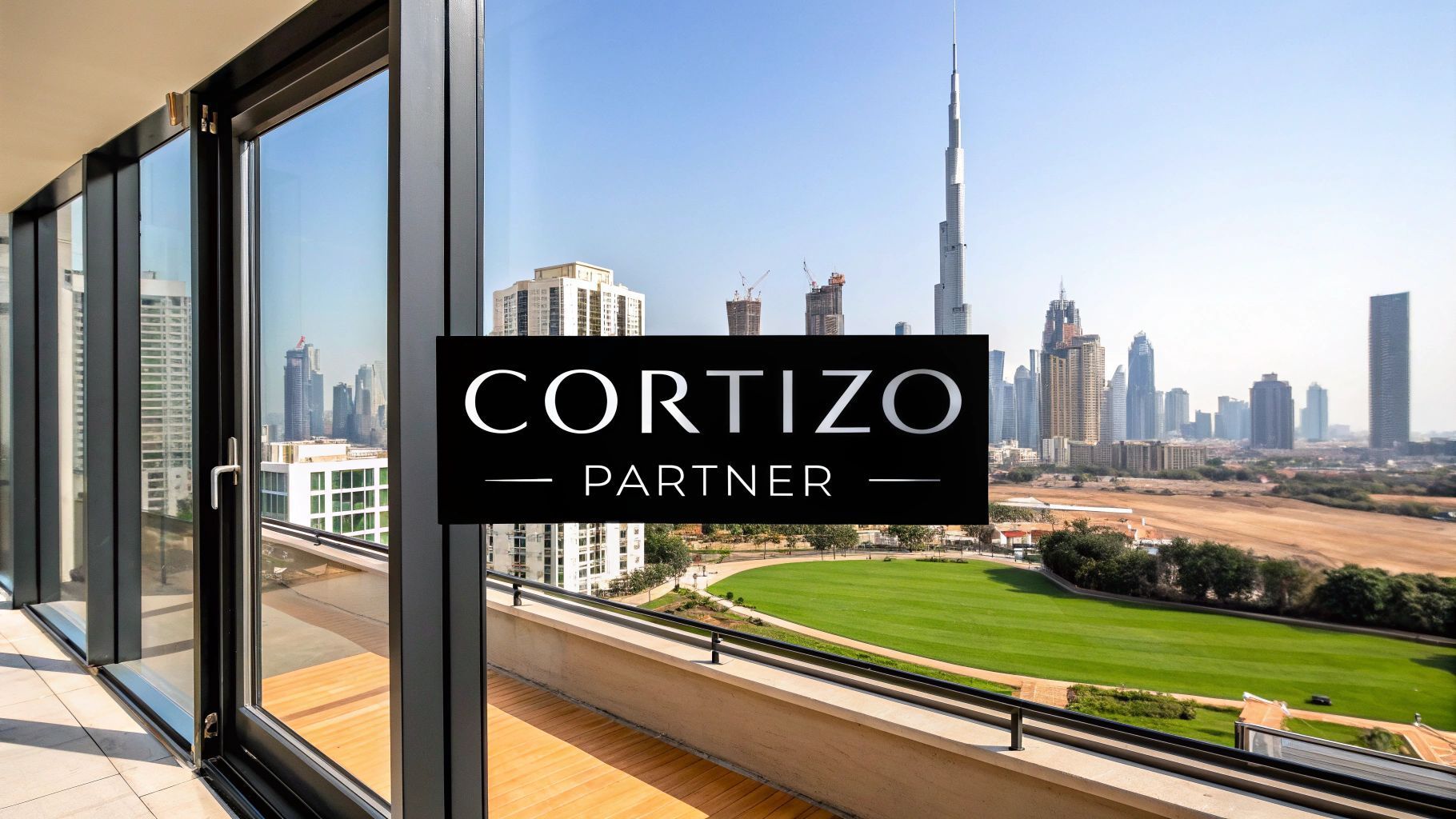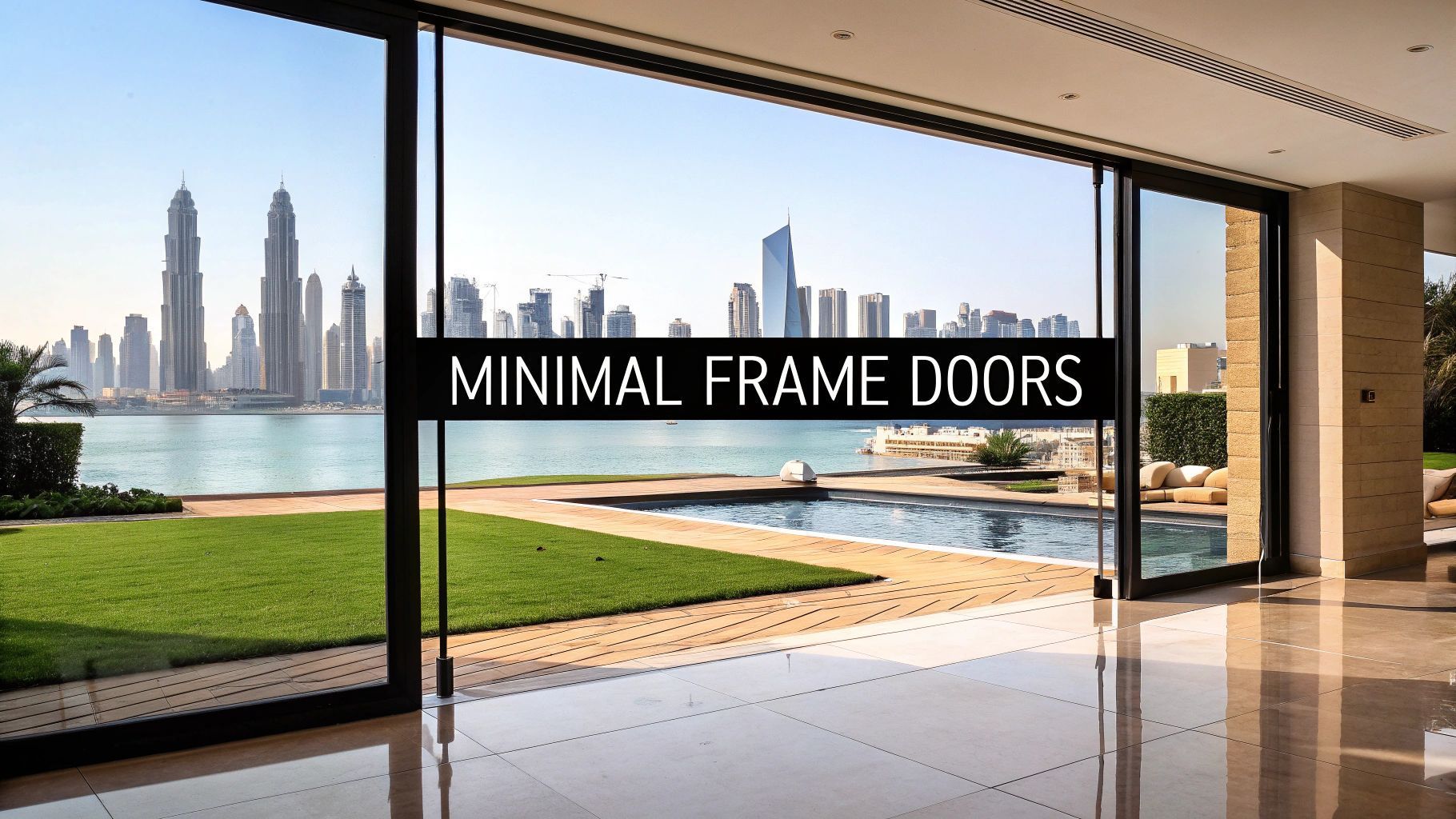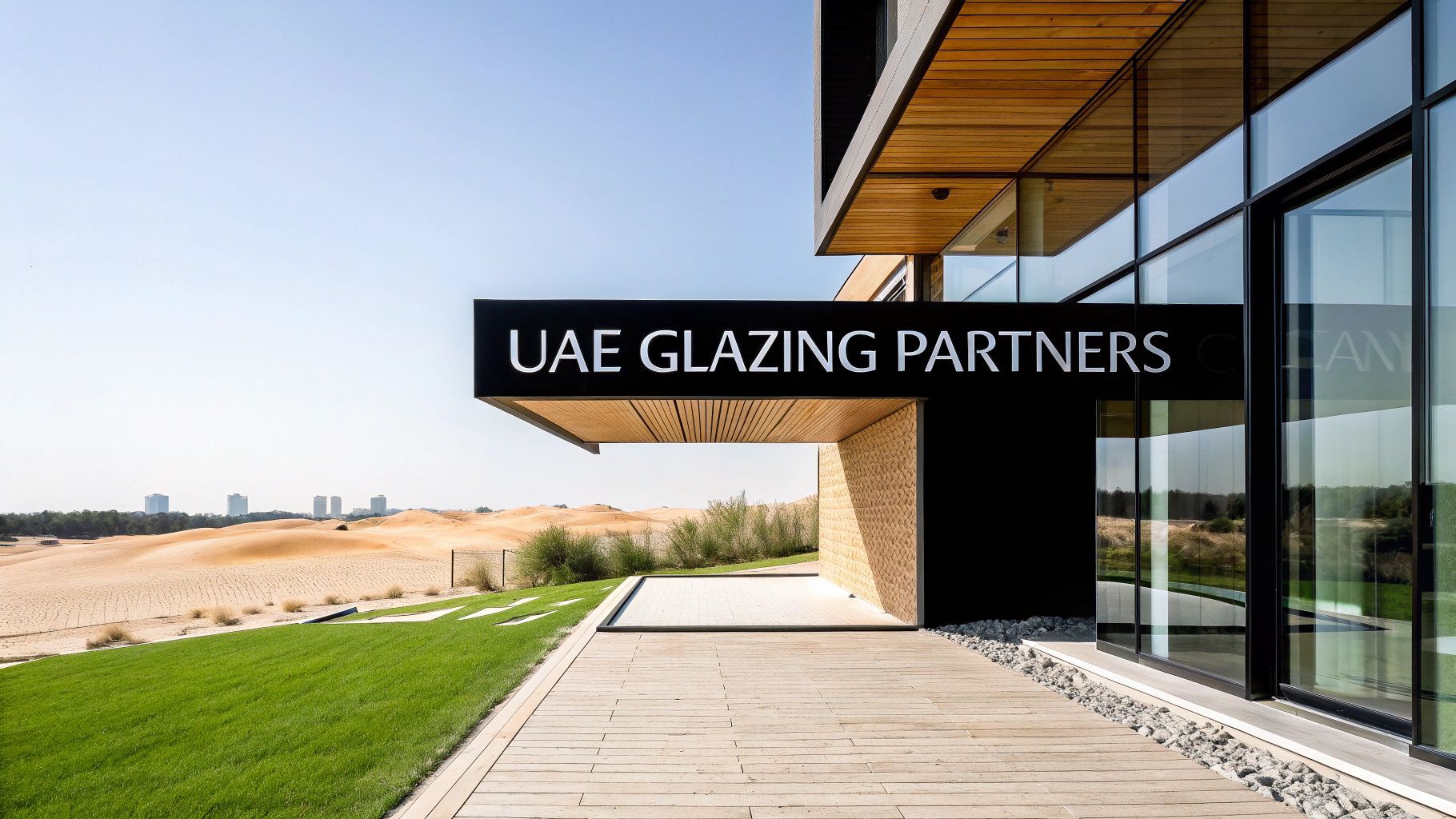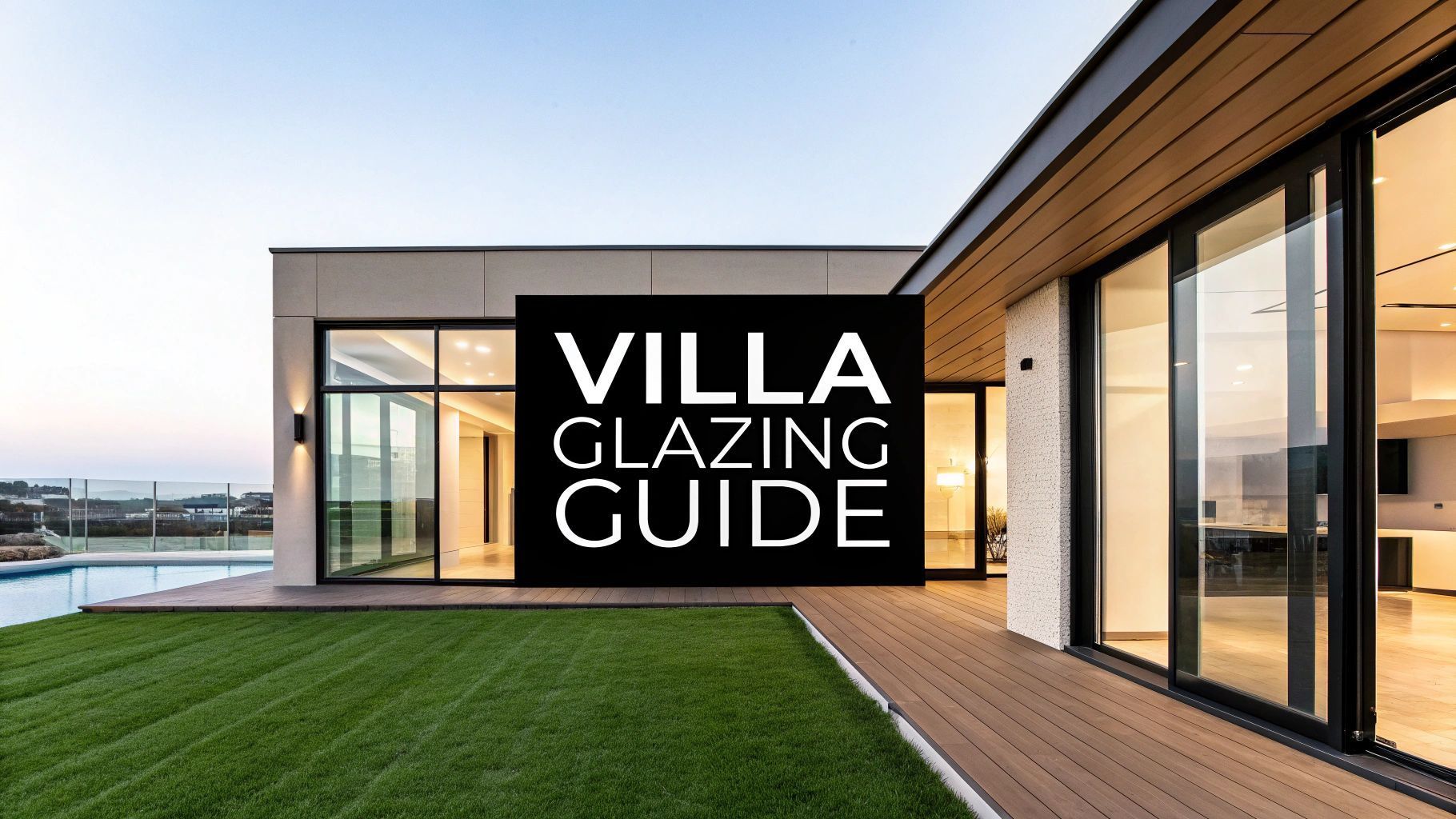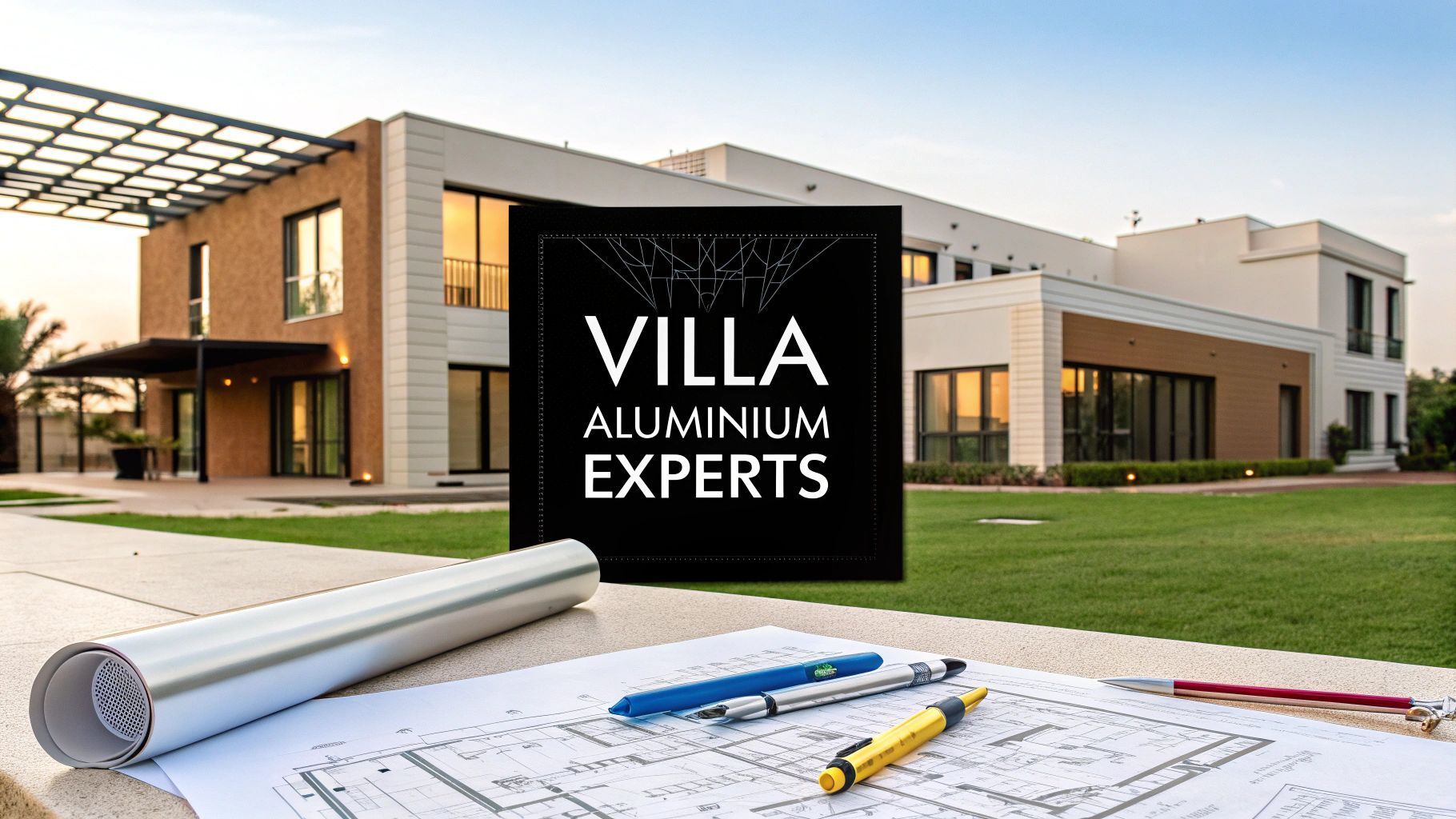A Guide to Curtain Wall Systems for UAE Villas
A Guide to Curtain Wall Systems for UAE Villas
So, what exactly is a curtain wall? It's a non-structural outer building skin, typically made of glass and aluminium. Think of it this way: it hangs from the building's main frame like a curtain hangs from a rod, which is where it gets its name. Because it doesn't carry any structural load, architects can design breathtaking, seamless glass facades.
This design freedom delivers the incredible panoramic views popular in modern UAE villas, from Palm Jumeirah to Arabian Ranches. A curtain wall allows for floor-to-ceiling glass, flooding interiors with natural light while providing a formidable barrier against the harsh climate.
What a Curtain Wall System Means for Your Villa
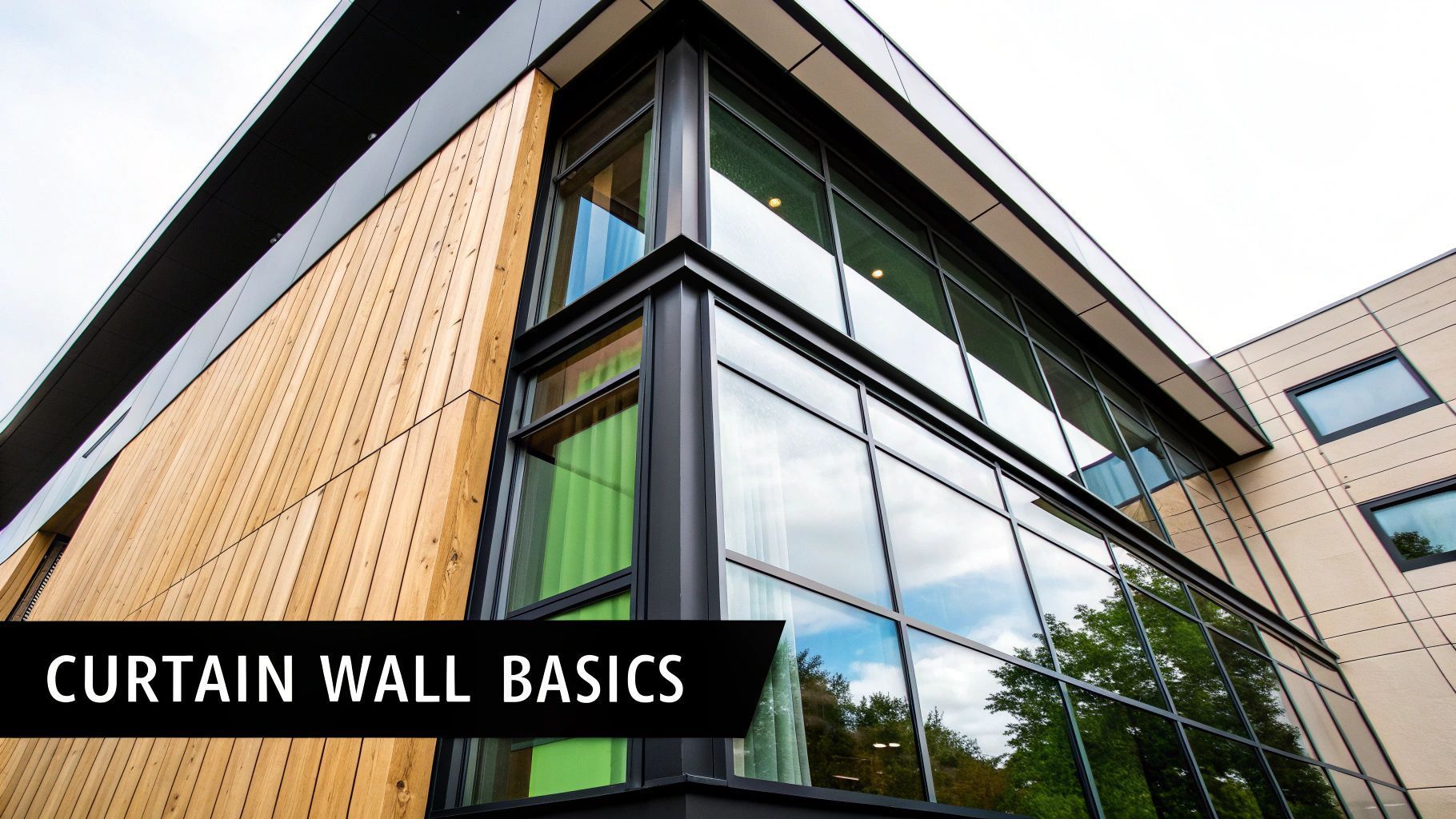
If a traditional villa wall is a heavy coat—providing both structure and protection—a curtain wall is a high-performance, lightweight jacket. It shields your home from Dubai's intense heat, dust, and humidity, but hangs off the building’s structural frame instead of holding it up.
This separation of the "skin" from the "skeleton" is what makes curtain wall systems so powerful for residential projects. Since it isn’t supporting the roof or floors, it can be crafted from lightweight glass and aluminium. This opens up entire walls to natural light and stunning views of your garden, pool, or the sea.
From Skyscrapers to Luxury Homes
While we often see curtain walls on Dubai's commercial skyscrapers, the technology is now perfectly adapted for villas. The goal is the same: create a jaw-dropping look while keeping the interior comfortable and energy-efficient, a critical need in the UAE's hot climate.
For homeowners, this translates into serious advantages:
- Uninterrupted Views: Swap solid walls for floor-to-ceiling glass, blurring the line between your indoor living space and your garden or pool area.
- Abundant Natural Light: Flood your home with sunlight. This creates a brighter, more welcoming atmosphere and can reduce your reliance on artificial lighting during the day.
- Superior Weather Protection: Advanced systems like those from Cortizo or Vetromax are engineered to form a tight seal against sand, dust, humidity, and noise.
- Enhanced Thermal Performance: Using thermally broken frames and specialised glass, a modern curtain wall acts as an insulated barrier against intense summer heat, helping to lower cooling costs.
The appeal of these systems in residential design is undeniable. The Middle East and Africa Glass Curtain Wall Market, valued at around USD 0.25 billion, is projected to soar to USD 0.44 billion by 2032. This growth is being fuelled by the demand for sleek, modern architectural styles in both commercial and high-end residential projects. You can explore more about these market trends and their drivers.
Specifying a curtain wall system for a new build or renovation is a true investment. It enhances your lifestyle and boosts your property's long-term value, elevating a standard home into a piece of contemporary architecture perfectly suited for the Emirates.
Curtain Wall Systems At a Glance
| Feature | Benefit for UAE Homeowners |
|---|---|
| Non-Structural Design | Allows massive glass panels with minimal framing, creating panoramic views in a Palm Jumeirah villa. |
| Lightweight Materials | Aluminium and glass add a modern aesthetic without heavy structural needs, ideal for sleek renovations. |
| Advanced Sealing | Provides excellent protection against sand and dust, keeping interiors in an Arabian Ranches home clean. |
| Thermal Breaks | Reduces heat transfer, meaning your AC works more efficiently and cooling bills are lower during Dubai's summer. |
| Floor-to-Ceiling Glazing | Maximises natural light, making living spaces feel larger and more connected to the outdoors. |
| Acoustic Insulation | High-performance glazing significantly reduces outside noise for a more peaceful home environment. |
Ultimately, a curtain wall isn't just a building component; it's a design statement that transforms how you experience your home.
If you're planning a renovation or villa upgrade in the UAE, Swift Rooms can help you specify the best window and door system for your project. Contact us today for a quote or consultation.
Choosing Your Curtain Wall Construction Method
When installing a curtain wall, how it’s built is as critical as the materials you choose. In the UAE, two primary methods dominate: stick-built systems and unitised systems. The right choice depends on your project’s scale, design complexity, and timeline.
Think of a stick-built system like having a suit custom-tailored on-site. An expert team assembles every piece—the aluminium frame, glass panels, and seals—directly at your villa. This offers incredible design flexibility, perfect for unique projects or tricky renovations.
On the other hand, a unitised system is about precision manufacturing. Large, complete sections are built and sealed in a controlled factory environment. These finished units are then transported to the site and hoisted into place, ensuring high quality and faster installation.
Stick-Built Systems: The On-Site Artisans
The stick-built method is the traditional, hands-on way of constructing a curtain wall. Because every component is assembled on location, it allows for last-minute adjustments and is well-suited for smaller-scale residential jobs or complex custom designs.
Picture a villa renovation in Dubai Hills with a unique, curved glass wall. A stick-built approach lets installers craft the frame and fit each glass panel meticulously, ensuring a flawless fit. You can dive deeper into the specifics in our detailed guide to stick system curtain walls in the UAE.
However, this method is more labour-intensive and dependent on weather conditions. On-site assembly requires extensive scaffolding and can take longer, a key factor for projects with tight deadlines. It also relies heavily on the skill of the installation team to manage UAE challenges like dust and moisture.
Unitised Systems: Precision Factory Fabrication
For larger projects, like a series of new-build luxury villas on Saadiyat Island in Abu Dhabi, a unitised system is often the better choice. Each massive panel is a self-contained unit, complete with framing and glazing, all assembled under strict factory conditions.
This off-site fabrication offers major advantages for UAE projects:
- Superior Quality Control: Assembling panels in a clean factory minimises exposure to on-site dust and humidity, resulting in a more reliable seal.
- Faster Installation: With most work done beforehand, the on-site phase involves lifting and securing the large panels, dramatically cutting down construction time and disruption.
- Consistent Performance: The factory process ensures every unit meets precise standards for thermal insulation and weatherproofing—critical for battling the region's extreme heat.
While unitised systems need more upfront planning, the speed and quality of on-site installation often make it the most efficient option for large-scale residential developments.
This decision tree shows how project scale and budget often point towards either a stick-built, unitised, or hybrid system.
As you can see, for larger projects, a unitised approach is often preferred, while stick-built systems offer a more cost-effective solution for smaller buildings or tighter budgets.
Picking the right method is a conversation between you, your architect, and your installer. By weighing your design goals against the project timeline and scale, you can choose the approach that delivers a flawless, high-performance curtain wall for your UAE home.
Selecting Materials That Beat the UAE Climate
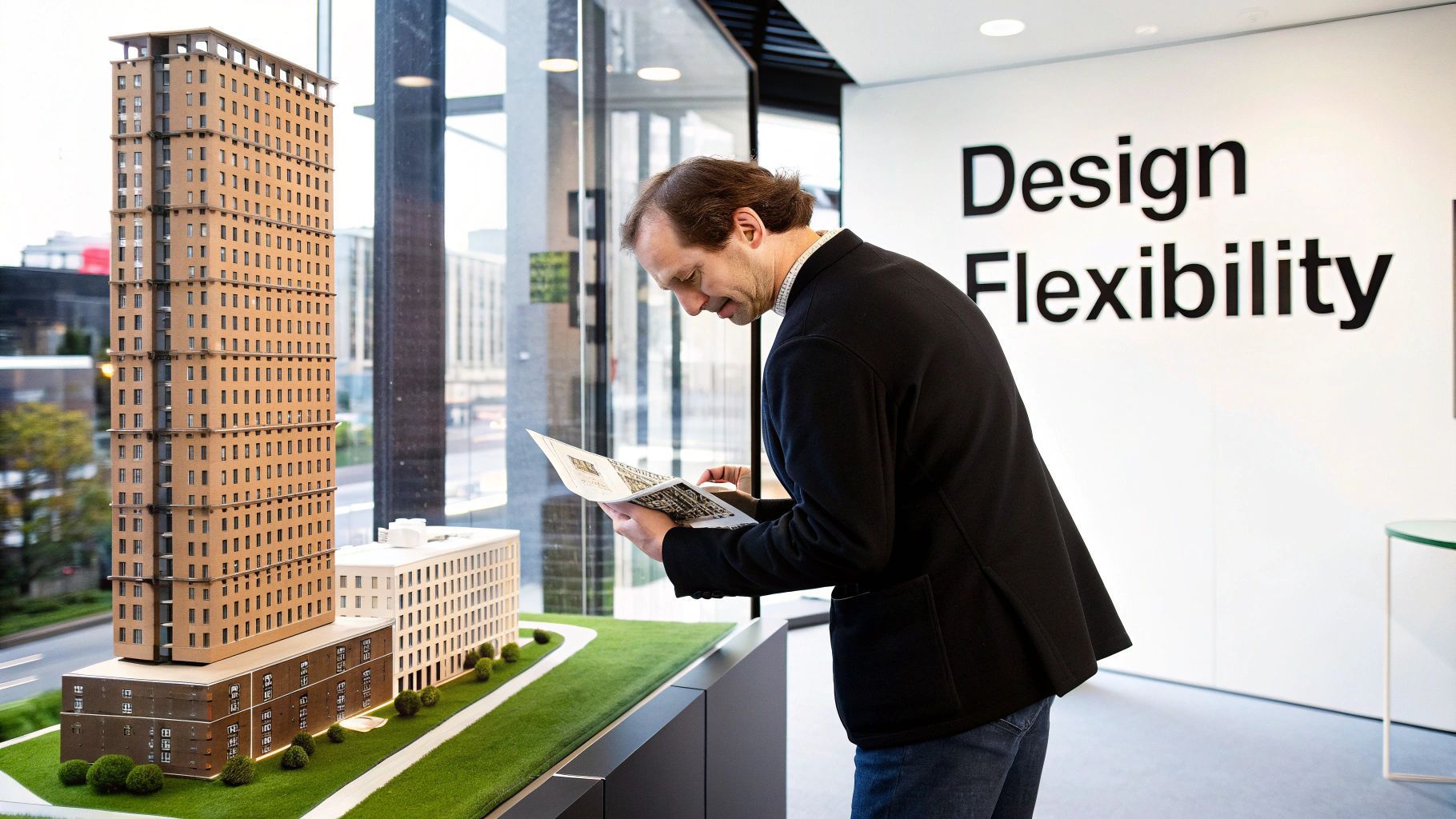
In the UAE, a curtain wall is only as good as its materials. Choosing the right components impacts your villa's comfort, energy bills, and ability to withstand the region's intense heat, humidity, and sand. The two most important elements are the framing and the glazing.
Think of these parts as your home’s first line of defence against the climate. A poorly specified system will let summer heat pour into your living spaces, forcing your AC to work overtime. The right materials, however, create a shield that keeps your home cool, quiet, and protected.
The Gold Standard for Framing: Thermally Broken Aluminium
For curtain wall framing in Dubai or Abu Dhabi, thermally broken aluminium is the best choice. Standard aluminium is a conductor, meaning it easily transfers heat. On a hot day, a solid aluminium frame will pass that thermal energy straight into your home.
The "thermal break" solves this. The aluminium frame is separated into two pieces (one outside, one inside) with a less conductive material, like polyamide, between them. This barrier effectively "breaks" the path of heat transfer, acting as an insulator.
Premium systems like Cortizo's Cor Vision Plus are engineered with this technology. The thermal break dramatically reduces the amount of heat passing through the frame, keeping your villa's interior significantly cooler and more comfortable during the peak of summer.
Selecting the right materials for your curtain wall is crucial, especially in the UAE climate, as it directly impacts thermal performance and potential for significant energy savings.
The demand for high-performance materials like thermally broken aluminium is a key trend in regional construction. In fact, the Middle East and Africa's aluminium curtain wall market is projected to expand with a CAGR of 7.8% through 2030, driven by major construction projects across the UAE.
Choosing the Right Glass: A Transparent Shield
The glass in your curtain wall is just as critical as the frame. A single pane of standard glass offers almost no insulation. For any residential project in the UAE, the minimum standard should be double-glazed units (DGUs).
A DGU has two panes of glass separated by a sealed air or gas-filled gap, which acts as an insulating layer. For even better performance, especially on south-facing walls exposed to direct sun, triple glazing adds a third pane and a second insulating gap.
The real game-changer for the UAE climate is a Low-E coating. Low-E (low-emissivity) is a microscopic, transparent metallic coating on the glass. It is engineered to reflect long-wave infrared heat (the kind you feel from the sun) while allowing visible light to pass through. It blocks the sun's heat from entering your home while still flooding your rooms with natural light.
Material Comparison for UAE Curtain Walls
Making the right choice comes down to weighing the benefits of each component. Here’s a simple comparison to guide your decision-making process with your architect or developer.
| Material Component | Best Choice for UAE | Key Benefits |
|---|---|---|
| Framing Material | Thermally Broken Aluminium | Excellent strength and durability. The thermal break is essential for stopping heat transfer and reducing cooling costs. |
| Glazing Type | Double or Triple Glazing | Creates an insulating gap that reduces thermal and acoustic transmission, keeping the home cooler and quieter. |
| Glass Coating | Low-Emissivity (Low-E) | Reflects solar heat while allowing natural light in. This is a non-negotiable feature for managing the UAE's intense sun. |
| Sealing System | High-Performance Gaskets | Creates a tight seal against sand, dust, and humidity, which is critical for maintaining indoor air quality and comfort. |
Investing in these high-performance materials ensures your curtain wall is a stunning architectural feature and a smart, functional system suited to the demands of living in the UAE.
Designing for Performance and Comfort
Beyond its stunning visual impact, a modern curtain wall is a high-performance system engineered for comfort. When designing a façade for a villa in the UAE, the focus must be on tackling the region's climate challenges: thermal efficiency, acoustic comfort, and weather resistance.
Think of a well-designed curtain wall as an intelligent barrier that keeps your home cool, quiet, and clean. It's a core part of your home’s environmental control. Getting these details right ensures your investment pays off with long-term comfort and energy savings.
Mastering Thermal Performance
In the UAE, controlling heat is everything. A curtain wall's ability to block solar heat gain, known as its thermal performance, is non-negotiable. An inefficient system will turn your home into a greenhouse, forcing your air conditioning to work overtime and sending utility bills soaring.
Advanced systems like Cortizo's Cor 70 shine here. Engineered with sophisticated thermal breaks, this system creates an effective insulated barrier within the aluminium frame. It stops heat from conducting from the scorching exterior to your cool interior, keeping the indoor temperature stable.
Imagine a villa in Arabian Ranches with a large, south-facing glass façade. By specifying a system with excellent thermal breaks and high-performance glazing, you can slash solar heat gain by over 60% compared to standard windows.
Creating a Quiet Sanctuary with Acoustic Insulation
Life in bustling UAE communities can be noisy. Unwanted sound from traffic or neighbours can disrupt the peace of your home. A curtain wall must also act as a powerful acoustic barrier to create a quiet sanctuary inside.
The secret to superior acoustic insulation lies in the glazing and seals. High-performance systems use laminated or acoustic glass, which has a special interlayer to dampen sound vibrations. Combined with advanced gaskets, it creates an airtight seal that blocks noise from entering. This is a game-changer for properties on Palm Jumeirah or near busy roads.
A Formidable Barrier Against Dust and Humidity
The UAE climate means a constant battle against dust, sand, and humidity. A curtain wall’s true test is its sealing technology. Subpar systems with poor gaskets will let fine dust and humid air seep into your home, compromising air quality and comfort.
Modern systems from suppliers like Vetromax or Deceuninck use multi-point locking and compression gaskets to create an exceptionally tight seal. This barrier keeps your interiors pristine and protected from the elements—a critical feature for a low-maintenance home in the UAE.
Integrating these performance features with smart home technology can elevate comfort even further. For integrating modern efficiencies, an intelligent design approach, as detailed in this IoT building automation guide, can connect your façade's performance with your home's climate control systems for optimal efficiency.
Seamlessly Integrating Indoor and Outdoor Living
A curtain wall shouldn't be an isolated feature; it should blend with other elements to create a fluid, indoor-outdoor lifestyle. This is where system compatibility becomes essential.
For example, a fixed curtain wall can be perfectly paired with large-format sliding doors like the Vetro Slide from Vetromax. This allows you to have a vast, uninterrupted wall of glass that also opens to a garden, creating a cohesive and functional living space. To learn more, see our guide on whether curtain wall systems can be opened.
If you're planning a renovation or villa upgrade in the UAE, Swift Rooms can help you specify the best window and door system for your project. Contact us today for a quote or consultation.
Navigating the Curtain Wall Installation Process

Installing a curtain wall is a carefully choreographed process where precision is everything, especially in the UAE's demanding climate. Understanding the journey from concept to completion helps set clear expectations and ensures a flawless result for your villa.
Knowing these steps will help you have more productive conversations with your architect and contractor, whether your project is in Dubai, Abu Dhabi, or another emirate. Let's break down how a seamless glass façade goes from an idea to a stunning reality.
Stage 1: Initial Design and Site Survey
It all starts with a detailed consultation to discuss your design goals, performance needs, and budget. Our expert team then conducts a thorough site survey at your villa, whether it's in a community like Arabian Ranches or on Palm Jumeirah.
We take precise measurements and assess the building's structure. This is where we lock in critical decisions, like the best system type—perhaps a sleek Cortizo profile or a robust uPVC system from Deceuninck—and the right glazing to beat solar heat. Getting this right from the start prevents costly surprises.
Stage 2: Off-Site Fabrication
Once designs are approved, the action moves to a controlled factory. This is a major advantage of modern curtain wall systems. All components, from the aluminium frames to the glass units, are cut, assembled, and sometimes even pre-glazed off-site.
This factory-based approach ensures superior quality control compared to on-site work. It protects sensitive assembly processes from the UAE's heat, dust, and humidity, leading to better seals and more reliable, consistent performance for your home.
Partnering with experienced installers is non-negotiable. Precision in waterproofing, structural integration, and sealing is absolutely essential for enduring performance against the UAE’s heat, humidity, and airborne dust. Minor errors during installation can lead to major issues like water leaks or poor thermal insulation.
Stage 3: On-Site Assembly and Sealing
With all components fabricated and delivered, the on-site team begins the final assembly. For a stick-built system, they build the frame piece by piece before fitting the glass. If it's a unitised system, large pre-made panels are carefully hoisted by crane and secured into place.
The final—and most crucial—step is sealing. Installers use high-performance gaskets and specialised sealants to create a completely weatherproof barrier. This detailed work ensures the curtain wall is airtight and watertight, protecting your home from sand, wind, and rain.
The demand for this level of expertise is growing fast. The Middle East and Africa’s glass curtain wall market, currently estimated at USD 790.28 million, shows just how committed the region is to this kind of advanced construction. You can read more about this market growth on cognitivemarketresearch.com.
If you're planning a renovation or villa upgrade in the UAE, Swift Rooms can help you specify the best window and door system for your project. Contact us today for a quote or consultation.
Your Questions About Curtain Walls Answered
We get many questions from homeowners and architects considering a curtain wall for a residential project. It's a big decision, so we've answered some of the most common ones to give you a clearer picture for your UAE villa.
Are Curtain Walls Just for Skyscrapers, or Can I Use Them in My Villa?
While we associate them with the iconic towers of Downtown Dubai, curtain wall technology has evolved. Today, premium systems from brands like Cortizo, Vetromax, and Deceuninck are engineered specifically for high-end villas.
You get the same stunning, floor-to-ceiling glass look but with the thermal performance and refined details suited for a luxury home. It's about bringing commercial-grade aesthetics and performance into a residential context, like an Emirates Hills villa, without compromise.
How Do These Huge Glass Walls Handle Dubai’s Heat and Sand?
It’s a valid concern, but systems designed for the UAE are built for the challenge. They are not simple panes of glass but a combination of smart technologies.
- Thermally Broken Frames: The aluminium frames have a built-in insulator that stops outdoor heat from transferring through the metal into your home.
- High-Performance Glazing: We use double or even triple-glazed units with special Low-E coatings. This reflects the sun's harsh rays away from your villa before they can heat the interior.
- Advanced Sealing Systems: High-quality gaskets and seals create an airtight and dust-tight barrier. This is your defence against sand, dust, and humidity, keeping your home clean and comfortable.
These three elements work together to ensure your home stays cool and clear, even during a mid-summer sandstorm.
What Does a Curtain Wall System Typically Cost?
A curtain wall is a premium investment and sits at a higher price point than standard windows. The cost reflects the advanced engineering, custom-sized and treated glass, and the meticulous installation required for a high-performance façade.
However, it’s important to look at the long-term value. The energy savings on your cooling bills can be substantial, and the impact on your property's resale value is undeniable. In luxury markets like Dubai, a curtain wall is an architectural statement that pays back in comfort and efficiency.
Can I Combine a Curtain Wall with Sliding or Pivot Doors?
Absolutely. This is one of their biggest strengths. Modern curtain wall systems are designed to integrate seamlessly with other architectural glazing.
It is common to design a large fixed glass façade and incorporate an operable element, like a Vetro Slide sliding door or a Vetro Pivot door. This gives you the incredible 'wall of glass' look while providing practical access to your garden, perfect for the UAE lifestyle.
If you're planning a renovation or villa upgrade in the UAE, Swift Rooms can help you specify the best window and door system for your project. Contact us today for a quote or a friendly consultation.

